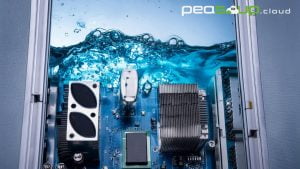Emerging Cloud Trends and the Role of Liquid Immersion Cooling
By leveraging emerging trends and incorporating innovative cooling technologies, the future of cloud computing efficiency appears brighter than ever.
Cloud computing has revolutionised the way businesses operate. It has provided flexible and scalable data storage, processing, and application deployment solutions. With the demand for cloud services having skyrocketed recently, the efficiency of the related infrastructures is crucial to ensure sustainable and high-performing operations. In this article, we explore the emerging trends in cloud computing and discuss the potential advancements in achieving efficiency.
Additionally, we will delve into the role of the liquid immersion cooling method in optimising cloud infrastructure performance while addressing sustainability concerns.
Emerging Trends in Cloud Computing
Emerging trends in cloud computing are shaping the industry’s future, driving advancements in efficiency and performance. Edge computing brings computation closer to data sources, hybrid and multi-cloud architectures optimise resource allocation, and containerisation enhances scalability.
With these trends, there has been a remarkable transformation in the way businesses operate in the cloud. They have enabled quick response times, improved user experiences, and greater flexibility.
With the continuous evolution of the cloud computing space, it is essential for business organisations to stay abreast to maximise their cloud infrastructure efficiency.
Edge Computing
With the increase of Internet of Things (IoT) devices and the need for real-time data processing, edge computing has gained a significant grip. Bringing computational power closer to the data source has helped reduce latency and enhance efficiency.
Cloud services providers are expanding their infrastructure to include edge nodes, enabling faster response times and improved user experiences.
Hybrid and Multi-Cloud Architectures
Business organisations are increasingly adopting hybrid and multi-cloud strategies to leverage the benefits of different cloud providers and platforms. This trend allows businesses to distribute workloads across public and private clouds based on specific needs, optimising performance, cost, and security. Efficient workload management and seamless data transfer between various cloud environments are becoming critical factors in achieving cloud efficiency.
Containerisation and Microservices
Containerisation, facilitated by technologies like Docker and Kubernetes, offers lightweight and scalable application deployment. By dividing applications into microservices, containerisation enhances resource utilisation and enables easy scalability.
This approach has improved efficiency and promoted agility and flexibility in cloud environments.
Advancements in Cloud Computing Efficiency
Artificial Intelligence (AI) algorithms are being integrated into cloud platforms to optimise resource allocation and workload management. Through predictive analytics, these technologies can analyse historical data and dynamically allocate resources, reducing wastage and improving overall efficiency.
Intelligent automation further enhances the operational efficiency of cloud infrastructure by automating tasks and optimising energy consumption.
Likewise, serverless computing, also known as Function as a Service (FaaS), has been critical in the abstraction of the underlying infrastructure, allowing developers to focus solely on code execution.
This approach has helped eliminate the need to provision and manage servers, reducing operational costs and improving scalability. Serverless architectures can dynamically scale based on demand, ensuring optimal resource utilisation and efficiency.
The Role of Liquid Immersion Cooling
Efficient cooling mechanisms are necessary to maintain optimal performance and prevent hardware failures.
Traditional air-based cooling methods are reaching their limits due to modern computing equipment’s increasing power density and heat. As a result, data storage and cloud providers are turning to cooling methods that are effective and efficient.
Liquid immersion cooling has been a promising solution in the industry.
Liquid immersion cooling involves submerging servers or entire racks in a dielectric liquid that efficiently absorbs and dissipates heat. This cooling method offers several advantages over traditional cooling.
First, it provides a higher cooling capacity, allowing for more densely packed servers and increased computational power within the same physical footprint. This allows better resource utilisation and reduces the need for additional data centre space.
Second, the cooling technique eliminates the need for energy-intensive air conditioning systems, leading to significant energy savings. Reducing power use contributes to sustainability efforts by lowering greenhouse gas emissions and reducing the overall environmental footprint of cloud computing infrastructures.
Third, liquid immersion cooling enhances hardware reliability and extends equipment lifespan. Keeping components at lower temperatures mitigates the risk of overheating and reduces thermal stress on sensitive parts. This improves system stability, reduces downtime, and decreases maintenance costs.
Due to its effectiveness and efficiency, liquid immersion cooling has emerged as a promising solution to address the cooling challenges of modern and future cloud infrastructures.
The cooling technique not only provides better capacity and energy efficiency but also helps improve hardware reliability and reduce the environmental impact of data storage and cloud computing.
By leveraging emerging trends and incorporating innovative cooling technologies, the future of cloud computing efficiency appears brighter than ever, allowing sustainable and high-performing cloud infrastructures for businesses worldwide.





